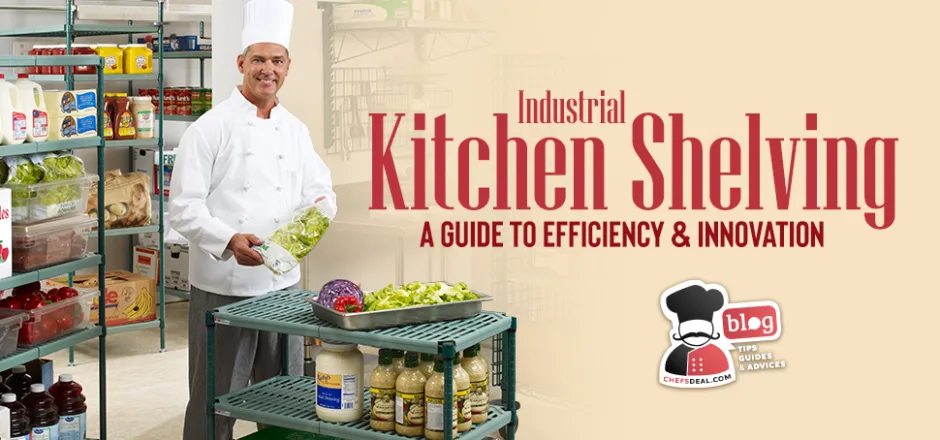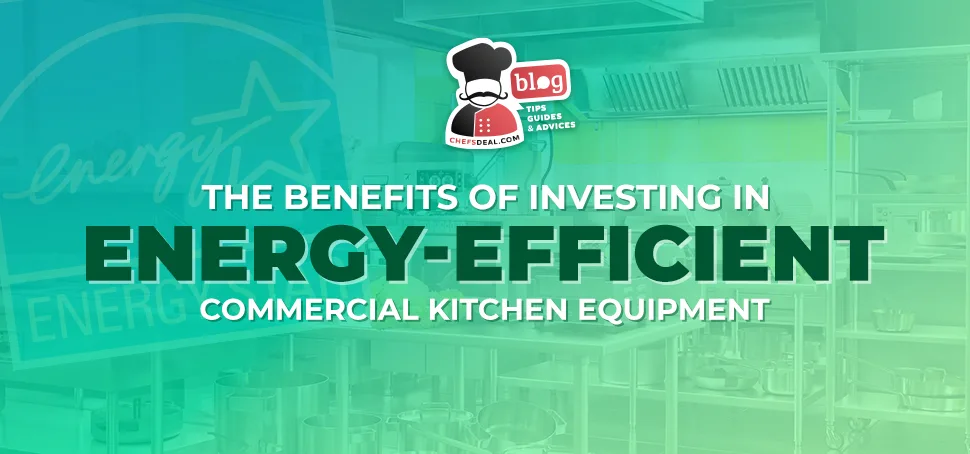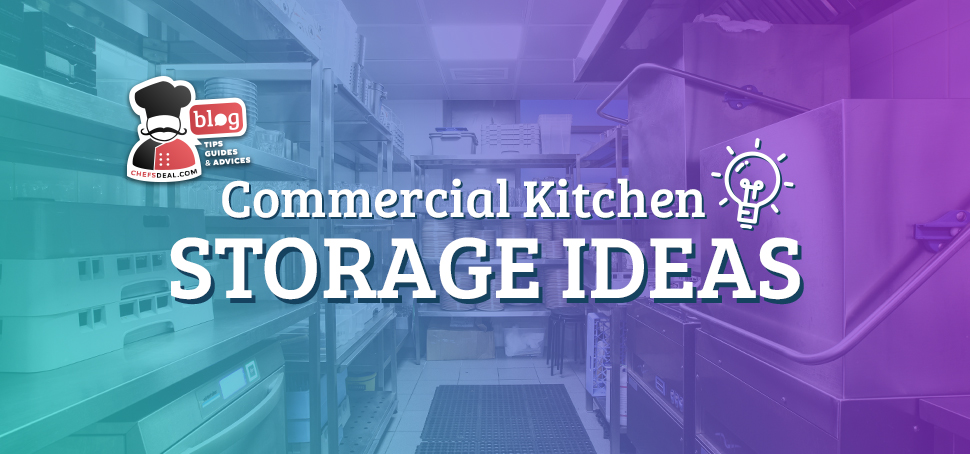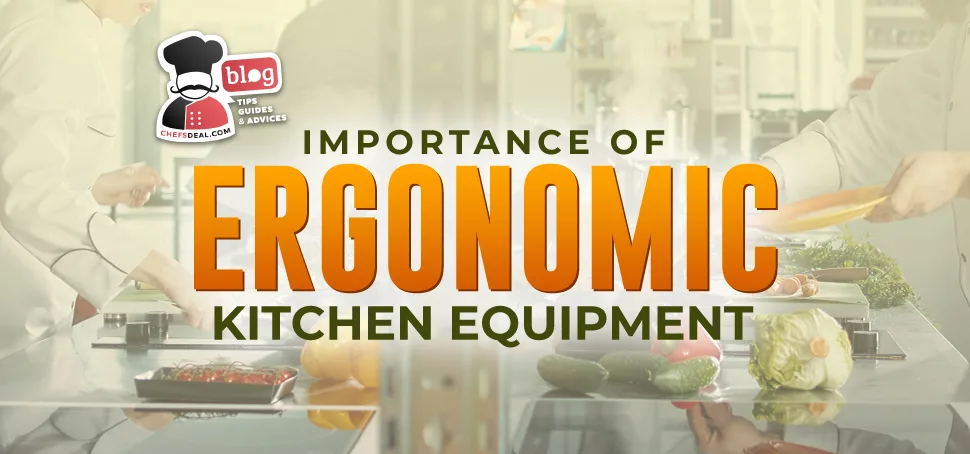In commercial kitchens, maintaining operational efficiency and optimizing storage are paramount. Industrial kitchen shelving stands as a vital component of kitchen storage, with 24 factors and features enhancing the efficiency and organization of overall operations.
It ensures durability, capacity for weight, corrosion resistance, and ease of assembly, among other essential factors. Stainless steel, known for its resilience, leads to the choice of materials, offering corrosion and humidity resistance vital in harsh kitchen environments. The ability to withstand heavy usage without wear makes it indispensable.
Another critical consideration is the shelving’s weight capacity. Units are designed to safely support between 600 and 1000 pounds (272.15 to 453.59 kg), depending on construction and material. This capacity is essential for securely storing heavy kitchen equipment and bulk supplies. Ease of assembly and compatibility with kitchen layouts ensure that shelving integrates seamlessly into various kitchen designs, promoting efficient space use and smooth workflow.
Corrosion resistance, facilitated by materials like galvanized steel and epoxy coatings, protects shelving in moisture-rich environments, extending its lifespan. Similarly, ventilation is crucial for maintaining shelf hygiene and product quality, particularly in storing perishable goods. Adjustable shelving offers flexibility, allowing kitchens to adapt to changing storage needs, while ease of cleaning ensures compliance with stringent food safety standards.
Innovative features like integrated utility hooks, customizable dimensions, and heat-resistant surfaces add functionality and efficiency, enabling kitchens to optimize their operations. Foldable or retractable designs and LED lighting enhance space utilization and visibility, respectively. Modular designs and multifunctional uses expand shelving’s versatility, accommodating various storage needs and kitchen sizes.
Eco-friendly materials and customized branding allow businesses to align their storage solutions with sustainability goals and brand identity. Innovative materials and specialized shelving cater to specific storage requirements, enhancing organization and operational efficiency.
Before discussing the details, 24 key factors of industrial kitchen shelving for efficiency and innovation are listed below:
- Durability
- Capacity for Weight
- Corrosion Resistance
- Ease of Assembly
- Compatibility with Kitchen Layouts
- Ventilation
- Adjustability
- Ease of Cleaning
- Integrated Utility Hooks
- Customizable Dimensions
- Heat-Resistant Surfaces
- Foldable/Retractable
- LED Shelving
- Modular Design
- Multifunctional Use
- Aesthetic Appeal
- Smart Storage Solution
- Eco-Friendly Material
- Customized Branding
- Innovative Material Usage
- Specialized Shelving
- Integrated Lighting
- Space-Saving Solutions
- Temperature-Controlled Sections
Alternative storage solutions, such as hanging racks, mobile carts, and under-counter cabinets, complement traditional shelving, offering alternative ways to maximize space and improve kitchen organization. Ceiling-mounted shelves, magnetic strips, and pull-out pantry shelves utilize underexploited spaces, further optimizing storage.
1. Durability
Durability is the key to industrial kitchen shelving, given the rigorous demands of a commercial kitchen environment. Shelving must withstand heavy use, frequent cleaning, exposure to various temperatures, and the potential corrosive action of food and cleaning chemicals. The choice of material significantly influences a shelving unit’s longevity and resilience. Among the materials commonly employed, stainless steel stands out for its exceptional strength and resistance to corrosion, humidity, and chemical wear.
Other durable materials include aluminum, known for its lightweight and rust resistance; galvanized steel, which benefits from a protective layer of zinc to combat corrosion; and polymers and polyethylene, which offer robustness in damp environments without succumbing to rust or corrosion. The specific application and placement within the kitchen can dictate the most appropriate material choice, balancing the need for durability with other considerations such as weight, cost, and maintenance requirements.
Additionally, the manufacturing process, including the type of coatings and finishes applied, is critical in enhancing durability. For example, powder coating can provide an extra layer of protection against scratches, dents, and chemical damage, thereby extending the shelf life of the shelving unit.
2. Capacity for Weight
The weight capacity of industrial kitchen shelving ensures shelf reliability, security, durability, and effective storage. The strength and quality of the material, thickness of the shelves, construction type, and design are some of the criteria showing how well the shelves can support weight.
Stainless steel, galvanized steel, and reinforced plastics are known for their capacity for weight and strength. The construction, material, and size of the shelves greatly affect their weight capacity. For instance, welded joints tend to be sturdy and capable of holding more weight than bolted joints.
The average weight capacity of industrial kitchen shelving is between 600 pounds (272.15 kg) and 888 pounds (402.8 kg) per unit. Yet, heavy-duty shelving units may have more capacity, up to 1000 pounds (453.59 kg), varying on the design and material. Manufacturers mostly provide weight capacity standards for the shelving units, indicating the maximum weight that each shelf or unit can safely bear. Observing the guidelines will ensure the safety of the shelving and the kitchen.
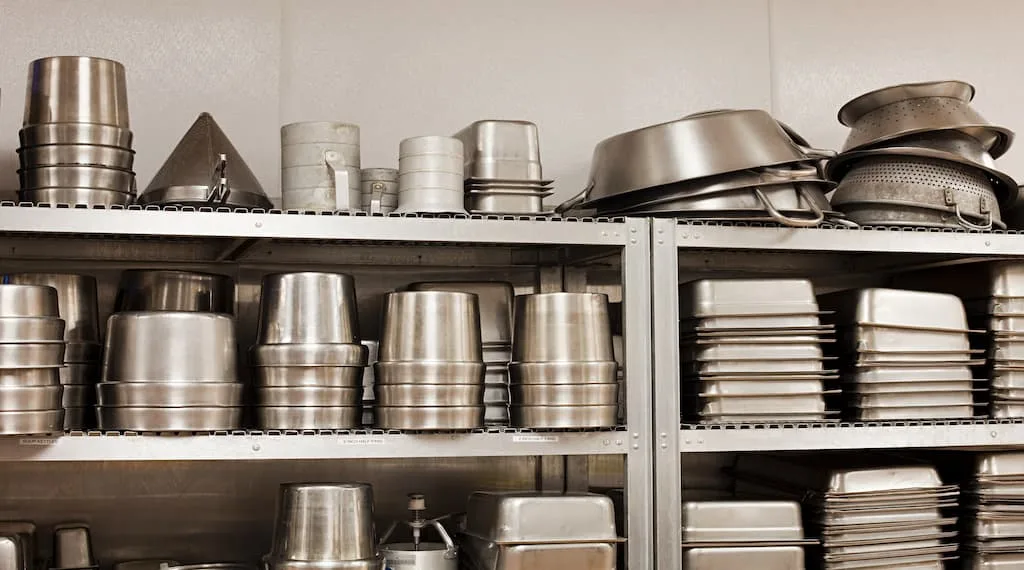
3. Corrosion Resistance
Corrosion resistance is a critical factor because industrial kitchen shelving is exposed to moisture, cleaning chemicals, and acidic or alkaline substances in diverse environments. Using stainless steel, galvanized materials, which are steel coated with zinc to prevent corrosion, and epoxy coating are some precautions to avoid corrosion in industrial kitchen shelving. Smooth and polished surfaces are less prone to collect moisture or pollutants, so corrosion is less likely. Choosing materials that are resistant to strong chemicals used in industrial environments will ensure durability and reduce the risk of corrosion.
4. Ease of Assembly
Ease of assembly simplifies kitchen set-up installation. Easy-to-assemble shelving ensures little downtime during installation, avoiding interrupting operations. The versatility of constructing easy-to-assemble industrial kitchen shelving allows for easy reconfiguration to changing storage or kitchen layout needs. Some of the shelving is designed to be installed simply without a need for expert help.
5. Compatibility with Kitchen Layouts
Compatibility of industrial kitchen shelving with kitchen layout enables efficient space usage, smooth workflow, and customization to meet specific requirements of different kitchens, providing an organized kitchen. Layouts vary greatly, and industrial kitchen shelving compatible with different kitchen layout requirements can accommodate various tools and equipment.
Shelving that is compatible with the layout allows for easy access, combines with equipment by not interfering with its functioning, can be customized for different items, and can be adapted for changes in a layout. Compatibility with the kitchen layout guarantees that storage units meet safety regulations with proper shelf spacing and attention to safety requirements, providing a safe working environment and lowering the chance of accidents and injuries.
6. Ventilation
Ventilation in industrial kitchen shelving refers to the design allowing air circulation throughout the shelves. Proper ventilation is required to control moisture from cleaning, cooking, and washing tasks to avoid corrosion and rust. It maintains hygiene by creating proper food storage conditions for perishable products by reducing bacteria and mold growth in humid environments and also reducing the danger of cross-contamination in a commercial kitchen. Ventilation in industrial kitchen shelving can be achieved through different design elements, such as open wire shelving, perforated shelves, and slotted designs. Furthermore, optimizing shelve spacing by placing the shelves at a proper distance from other surfaces and walls ensures effective ventilation.
7. Adjustability
The adjustability of industrial kitchen shelving is required to meet the needs of ever-changing kitchens. It gives the flexibility to change the design of the storage to meet the changing demands of the kitchen. The possibility to adjust the heights and places of the shelves provides versatile storage solutions by accommodating different items and equipment. The adjustability of industrial kitchen shelving optimizes the space by utilizing vertical space, provides easy cleaning, and organizes the kitchen for better efficiency.
Proper height is a question when installing industrial kitchen shelving. But there is no right height for hanging the shelves; it changes depending on the user’s choice, environment, purpose, and usage of the shelves. Yet, the standard heights to install shelves are 18 inches (45.72 cm) above the countertop surface and 54 inches (137.16 cm) above the floor.
8. Ease of Cleaning
Industrial kitchens must comply with food safety regulations. Easy-to-clean kitchen shelving helps to avoid the development of germs, contaminants, and pathogens, providing a safe environment. Kitchen shelving made of materials like stainless steel, aluminum, and polyethylene provides easy cleaning. Regular cleaning of shelve surfaces eliminates spills, residues, and accumulations, reducing the risk of cross-contamination between food and utensils. Providing hygienic storage also prevents pest attraction.
9. Integrated Utility Hooks
Hooks are functional in all kitchens with their versatility and various benefits and usage areas. Integrated utility hooks add extra functionality to industrial kitchen shelving by maximizing shelving space and providing easy reach for necessary items. Utility hooks organize utensils, tools, and small cookware, reducing clutter on the shelving surface and the countertop space, which is useful, especially in small kitchens. It also provides an organized storage area and easy access to the tools, which can boost workflow efficiency. Another benefit of integrated utility hooks is easy air-drying for kitchenware after washing, reducing moisture buildup and promoting hygiene.
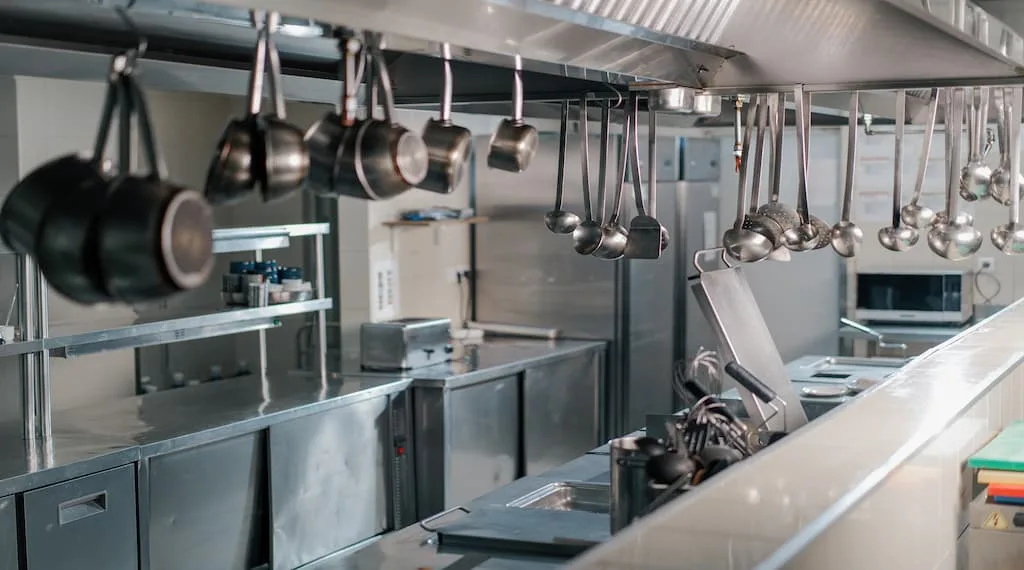
10. Customizable Dimensions
Customizable dimensions of industrial kitchen shelving make it flexible, efficient, and adaptable to any space, tailoring it to specific needs. Customizable kitchen shelving fits different layouts and spaces, allowing users to personalize the shelving according to their storage needs to create an efficient workplace. It also allows the storage area to be changed to fit different-sized items based on the changing needs of the kitchen. Furthermore, customizable dimensions of industrial shelves help design an ergonomic kitchen by allowing users to customize shelf heights to their preferred levels. This reduces strain and tiredness for the staff, resulting in a safer and more efficient workplace.
11. Heat-Resistant Surfaces
Heat-resistant surfaces on industrial kitchen shelving are designed to protect the surfaces from high temperatures. Materials or coatings of the shelves make the surfaces resistant to heat and avoid warping, melting, or deterioration. Shelves alongside cooking areas and equipment such as ovens, grills, and fryers need to be heat-resistant so as not to get damaged from excessive heat. High temperatures can deform some elements, such as plastic or some metals. Heat-resistant surfaces provide durability and expand the lifespan of the shelving.
12. Foldable/Retractable
Foldable or retractable shelving can be folded approximately one-third of its original width when unused, providing compact storage and saving space, which is vital, especially for small kitchens. It provides facility during cleaning, ensuring all edges are accessible for proper cleaning. Kitchens may need extra storage for events, catering services, or during peak times. Foldable shelving can meet these requirements and then be folded away after use, offering flexibility. They also come in handy for food trucks and pop-up kitchens; their foldable design makes them easy to carry and install wherever needed.
13. LED Shelving
Led shelving is the industrial kitchen shelving equipped with LED lightning. Using LED lighting on the shelves creates an appealing display and improves the presentation of products. It provides a clear vision and creates an aesthetic environment, especially in open kitchens where customers can see the kitchen.
14. Multifunctional Use
Multifunctional use of industrial kitchen shelving enhances its efficiency and overall kitchen productivity apart from using only for storage. Carts or moveable shelf units serve multiple functions, such as moving huge tools and equipment within the kitchen or serving finished meals. You can design shelves for multiple purposes, such as integrating counters on shelving units to use them as workstations with necessary tools, optimizing workspaces, and enhancing efficiency. Using additional attachments or tools such as hooks, racks, and LED lighting, you can turn simple shelving into display areas for menu items or create multifunctional and versatile storage options.
15. Modular Design
Modular design refers to kitchen shelves that can be assembled, disassembled, and rearranged depending on the specific needs of the kitchen. It provides versatility to use shelving units in different ways for different items and purposes, adaptable for different storage options. Interchangeable shelves are an example of modular design, allowing the mixing and matching of components for creating custom configurations, such as combining shelves with drawers and cabinets for making a specific storage unit. Stackable shelving units are designed to be stacked on top of each other, making a vertical storage unit and maximizing space.
16. Aesthetic Appeal
Merging function with style when designing the shelving of the kitchen creates a functional and visually appealing space with simple steps. Using high-quality materials in shelving provides durability and contributes to creating an aesthetic environment. Opting for modern design elements like geometric shapes, clean lines, and minimalistic touches in the design of the kitchen helps create a more sleek and clean environment. Merging open and closed storage enhances both functionality and visual appeal, such as using open shelving for small and frequently used items while placing less used and huge tools in closed cabinets.
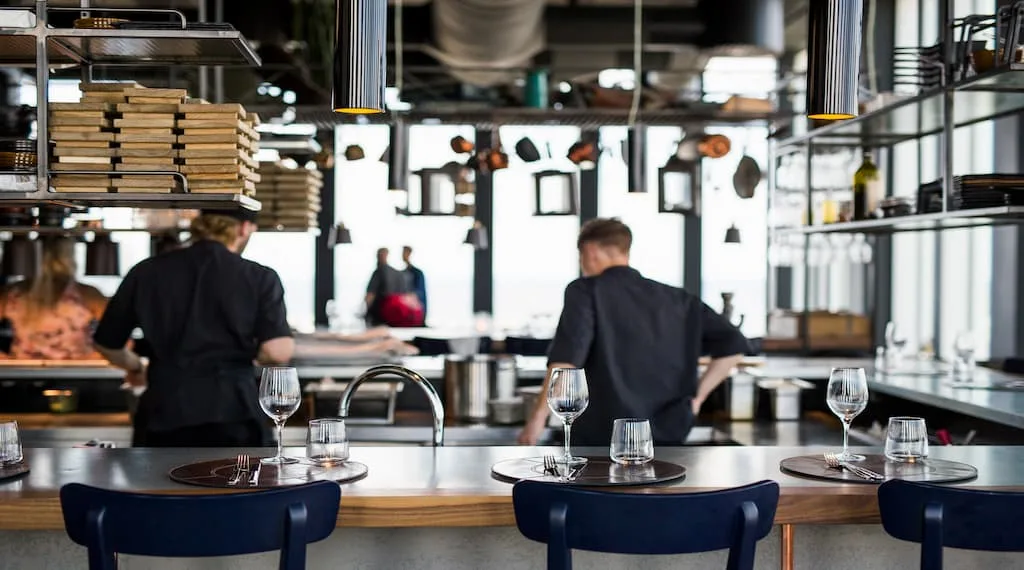
17. Smart Storage Solutions
Smart storage solutions for commercial kitchens enhance functionality, efficiency, and production by embracing technology and innovative ideas.
Smart labeling on storage shelving provides digital information about stored items via shelf labels or NFC tags. These labels can include product information, expiration dates, allergy information, and even recipe recommendations, providing easy inventory management.
Integrating smart sensors inside the shelves provides beneficial data, such as humidity levels or temperature changes in food storage, that can affect food safety. This allows for prompt intervention and reduces food waste.
Integrated scales in kitchen shelving present extra efficiency. These scales measure stored items, which can benefit portion control, recipe preparation, and inventory management.
18. Eco-Friendly Materials
Using eco-friendly materials in kitchen shelving has various environmental impacts, such as reduced resource depletion and pollution during manufacturing. Eco-friendly products are often made of organic materials, avoiding dangerous chemicals, which provides healthier and safer use. Using sustainable materials in your operation improves the company’s reputation and builds customer trust.
Bamboo is one of the eco-friendly materials used in kitchen shelving. Its fast-growing process and being a renewable source make it sustainable. Additionally, it is lightweight, durable, and antibacterial, making it an excellent material for kitchen shelving.
Recycled materials such as steel and plastic are eco-friendly and durable alternatives, minimize waste, and have a lower environmental footprint than conventional steel and plastic.
Cork is a material harvested from the bark of cork oak trees, which is natural, renewable, water-resistant, and lightweight, making it ideal for moist environments.
19. Customized Branding
Customized branding in industrial kitchen shelving design helps personalize your space. Working with a manufacturer can create a unique shelving that matches your style, layout, and branding. For a distinctive style, you can incorporate your brand, logo, and colors or patterns of your concept into the shelving design.
20. Innovative Material Usage
Innovative material usage in industrial kitchen shelving enhances efficiency, sustainability, and durability with the use of new and advanced materials. Innovative materials makes kitchen shelves endure the harsh conditions and heavy usage of commercial kitchens with decreased weight, increased durability, and improved functionality with features such as heat, corrosion, and moisture resistance. Carbon fiber composite, bamboo composite, and bio-based plastics are some of the innovative materials that are lightweight yet sturdy and easy to install and maintain, boosting sustainability.
21. Specialized Shelving
Specialized shelving optimizes layout and enhances efficient space usage, providing an organized environment in commercial kitchens. Shelvings designed for specific equipment, tools, and purposes allow you to choose the best option for your needs.
Sheet pan racks, for example, are designed for storing and transferring baking sheets, trays, and pans. Their design allows for optimal air circulation around baked items and provides easy loading for pans. Wine rack shelving is designed to keep wine bottles at a proper angle to protect wine quality and provide air circulation to maintain proper temperatures. Equipment shelves are designed to place heavy equipment such as mixers and food processors as a sturdy platform, freeing counter space and providing extra workspace. Wine glass racks are another specialized shelving designed to hold wine glasses at an upside-down position, allowing for air drying and reducing breakage.
22. Integrated Lighting
Integrated lighting in kitchen shelves provides brightness for staff to see inside the shelves clearly to find what they need quickly and easily, saving time. Lighting illuminates storage areas, lowering the chance of accidents and making it simpler to differentiate the items on the shelves, minimizing mistakes. It makes it easier to place items and read labels, reducing the time and effort spent on finding items and making it effective in busy times. It also eliminates potential risks and injuries, such as sharp items or spills, providing a safer working environment. The efficient lighting in or around the shelves reduces eye strain of the staff, improving performance.
23. Space-Saving Solutions
Implementing space-saving shelving options in limited spaces optimizes storage capacity and improves organization without sacrificing performance and productivity. Using vertical space from floor to ceiling maximizes kitchen space, and adjustable shelves provide flexibility for different-sized items. Installing hooks or racks under existing shelves turns unused space into extra storage space for holding utensils, cups, or frequently used tools while saving shelf space at the same time. Hanging shelves is another use of vertical space to hold pots and pans, freeing up great shelf space for other items. Using rotating shelves or carousels in unusable corners and tight spaces between equipment maximizes storage capacity and makes use of every footage of the kitchen.
24. Temperature-Controlled Sections
Temperature-controlled sections are shelving units with heating or cooling capabilities for keeping food items at proper temperatures. Cooling shelving cabinets are designed to keep products fresh and at safe temperatures, reducing waste and ensuring compliance with food safety regulations. Heated storage units are designed to keep cooked food at serving temperatures, saving time in the kitchen and preserving food quality. Keeping products at proper temperatures extends their storage period, reducing restocking frequency and overall operation costs.
Integrating Industrial Kitchen Shelving with Overall Kitchen Design
Integrating industrial kitchen shelving with overall kitchen design ensures both a visually appealing environment and a functional working area. The choice of materials has a crucial role in fitting the shelving into the broader context of kitchen design. The material of the shelving, whether metal, wood, or plastic, should align with the aesthetic of the kitchen for a cohesive layout. Matching the colors and design features contributes to a unified design as well. Placement of the industrial kitchen shelving is critical to create an efficient workflow and maximize space while also avoiding visual clutter. Maximizing vertical space and ensuring that industrial shelving fits seamlessly with equipment design help to create a harmonious and efficient cooking environment.
10 Alternative Storage Solutions in Commercial Kitchens
Alternative storage solutions are utilized to maximize space, organization, and efficiency in a commercial kitchen setting. These alternatives to traditional shelving units can enhance the functionality of a kitchen by providing specialized storage options that cater to different needs and spatial constraints.
In addition to adhering these 10 alternative storage solutions to the main commercial kitchen storage ideas, you can produce alternative storage solutions according to the characteristics and needs of your business, maximizing kitchen space and enhancing efficiency. 10 alternative storage solutions are listed below:
- Hanging Racks
- Mobile Storage Carts
- Under-Counter Cabinets
- Ceiling-Mounted Shelves
- Wall-Mounted Magnetic Strips
- Pull-Out Pantry Shelves
- Over-the-Door Organizers
- Stackable Bins and Baskets
- Corner Shelving Units
- Pegboard Systems
Hanging Racks
Hanging racks can be wall or ceiling-mounted and used to organize cookware, pots, pans, and other utensils using vertical and unused space. They keep frequently used items within easy reach and free up shelving space.
Mobile Storage Carts
Mobile storage carts are freestanding and movable storage items with wheels or casters. They are versatile and mostly feature multiple racks, shelves, drawers or cabinets for storing and transferring different items, providing great versatility.
Under-Counter Cabinets
Using under-counters for storage is an efficient use of space for storing less frequently used items, freeing up counter space and creating a more organized environment.
Ceiling-Mounted Shelves
Ceiling-mounted kitchen shelving efficiently uses overhead space and provides extra storage capacity. It is effective for small kitchens with limited floor and wall space.
Wall-Mounted Magnetic Strips
Magnetic strips are metal bars or strips mounted on walls for storing metal tools and knives. The magnets securely hold knives and metal tools, saving drawer and counter space and providing easy access. It is also great for display, contributing to kitchen ambiance.
Pull-Out Pantry Shelves
Pull-out pantry shelves are storage trays or baskets fixed on slides within pantry cabinets that can be easily extended to provide easy access to items inside. They maximize storage space, increase organization, and allow simple access to the products in deep storage spaces.
Over-the-Door Organizers
Over-the-door organizers are designed to hang over doors for extra storage space with drawers, pockets, or shelves for storing smaller items or spices. They maximize storage space by using unused places and save shelf space.
Stackable Bins and Baskets
Stackable food storage bins or baskets are containers with lids used to organize and store dry goods, pantry items, or small kitchen tools. These bins are stackable, using vertical space, and they mostly have clear construction for easy identification of contents.
Corner Shelving Units
Corner shelving units are designed to fit into the corners, making use of underutilized spaces in the kitchen. They provide extra storage space while taking up minimal floor space.
Pegboard Systems
Pegboards are simply panels with holes made of different materials and used to hang a variety of tools and utensils. The tools are hung using hooks inserted in regularly placed holes on the board. The hooks and pegs can be customized for whatever will be hung. It uses vertical space greatly and offers flexibility.
Conclusion
Integrating industrial kitchen shelving with the overall kitchen design is paramount for achieving both efficiency and aesthetics in commercial kitchens. Considering the key factors of industrial kitchen shelving provides insight into how using the right kitchen shelving can optimize storage space and align with the kitchen layout for an organized environment and effective operation.
The construction types, innovative and practical features, material choices, smart solutions, and additional components of industrial kitchen shelving maximize space and enhance functionality and efficiency. By integrating restaurant shelving with the broader kitchen design, businesses can optimize efficiency, streamline operations, and create a visually appealing space that enhances the overall dining experience for customers.

